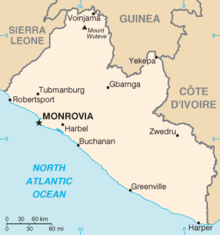1980 Liberian coup d'état
 | |
| Date | 12 April 1980 |
|---|---|
| Location | Monrovia, Liberia |
| Type | Military coup |
| Cause |
|
| Motive | Regime change |
| Target | Executive Mansion, Monrovia |
| Organised by | Samuel Doe |
| Participants | 17 members of the Armed Forces (NCOs and soldiers) |
| Outcome | Coup succeeds
|
The 1980 Liberian coup d'état happened on April 12, 1980, when President William Tolbert was overthrown and murdered in a violent coup. The coup was staged by an indigenous Liberian faction of the Armed Forces of Liberia (AFL) under the command of Master Sergeant Samuel Doe. Following a period of transition Doe ruled the country throughout the 1980s until his murder on 9 September 1990 during the First Liberian Civil War.
Events

In the early hours of April 12, 1980, 17 non-commissioned officers (NCOs) and soldiers of the AFL led by Master Sergeant Samuel Doe launched a violent coup d'état. All of the conspirators were indigenous Liberians, while Tolbert belonged to Americo-Liberians, the community which had ruled the country since the Liberian Declaration of Independence in 1847. The group entered the Executive Mansion (presidential palace) and killed Tolbert, whose body was dumped into a mass grave together with 27 other victims of the coup. It is reported that Harrison Pennoh was the person that killed Tolbert. Later, a crowd of angry Liberians gathered to shout insults and throw rocks at the bodies.[when?][1]
Aftermath
By the end of April, most of the cabinet members of the Tolbert administration had been put on trial in a kangaroo court and sentenced to death. Thirteen of them were publicly executed by firing squad on 22 April at a beach near the Barclay Training Center in Monrovia. The executed were:[2][3][4][5]
- Frank E. Tolbert — brother of President Tolbert and President pro tempore of the Senate
- Richard A. Henries — Speaker of the House of Representatives
- E. Reginald Townsend — National Chairman of the True Whig Party
- P. Clarence Parker II — Chairman of the National Investment Council and Treasurer of the True Whig Party
- James A. A. Pierre — Chief Justice of the Supreme Court
- Joseph J. Chesson Sr. — Minister of Justice
- Cecil Dennis — Minister of Foreign Affairs
- Cyril Bright — former Minister of Planning and Economic Affairs
- John W. Sherman — Assistant Minister of Commerce and Trade
- James T. Phillips — former Minister of Finance, former Minister of Agriculture
- David Franklin Neal — former Minister of Planning and Economic Affairs
- Charles T. O. King — Deputy Minister for Agriculture
- Frank J. Stewart Sr. — Director of the Budget
The executions were described by Larry C. Price as a "nightmarish scenario" in which the executed men were "murdered in front of screaming crowds of jubilant indigenous Liberian citizens." Cecil Dennis was the last man to be shot and was reported to have defiantly stared his killers down whilst uttering a prayer before his execution.[6]
Only four members of the Tolbert administration survived the coup and its aftermath; among them was the Minister of Finance, future President Ellen Johnson Sirleaf,[7] the Vice President Bennie Dee Warner[8] and agricultural minister Florence Chenoweth.[9] Chenoweth was able to escape to neighboring Sierra Leone before making her way to the United States while Warner was out of the country at the time of the coup. Both Sirleaf and Chenoweth later returned to Liberian politics after Doe's death.
Following the coup, Doe assumed the rank of General and established the People's Redemption Council (PRC), composed of himself and 14 other low-ranking officers, to rule the country. The PRC was dissolved after the 1985 general election, in which Doe was elected President; he was sworn in on 6 February 1986. Doe continued to rule the country until he was murdered on 9 September 1990 by the INPFC, led by Prince Johnson, during the First Liberian Civil War.
References
- ^ "LIBERIA: After the Takeover, Revenge". TIME Magazine. 1980-04-18. Archived from the original on September 28, 2008.
- ^ Leon Dash, "Liberian Soldiers Taunt, Shoot 13 Former Leaders", The Washington Post, April 23, 1980.
- ^ "Liberia's Dark History – The Coup of 1980", TLC Africa.com.
- ^ Global News Monitor for April 15–30, 2005 – Liberia, Prevent Genocide International.
- ^ Source: Ellen Johnson Sirleaf, This Child will be Great. Memoirs of a Remarkable Life by Africa's First Woman President, p. 102. Cited in Liberia: Past and Present of Africa's Oldest Republic.
- ^ "Cabinet ministers lined up for execution after a coup d'état in Liberia, 1980". 11 March 2014. Retrieved 18 June 2020.
- ^ Johnson Sirleaf, E: This Child Will Be Great, p. 103. HarperCollins, 2009.
- ^ "Tolbert's Aide in U.S." (PDF). The New York Times. April 13, 1980. Retrieved October 21, 2011.
- ^ "Florence Chenoweth: Champion of Food Security". University of Wisconsin. Retrieved 30 May 2020.
